
Mustelus henlei
This small, slender shark has a long snout, large eyes, triangular fins and an asymmetrical, notched caudal (tail) fin. It prefers coastal waters of the eastern Pacific Ocean, usually muddy or sandy bottoms of bays, solitary or schooling with other species of small sharks. It is an iridescent reddish-brown on top, fading to white underneath, and averages around 2 feet long, but can grow to over 3 feet long. Because of its size, it is considered harmless to humans, and although it isn’t a popular food fish, it is popular in public aquariums because it adapts well to captivity.
Order – Carcharhiniformes
Family – Triakidae
Genus – Mustelus
Species – henlei
Common Names
Common names of Mustelus henlei include brown smooth-hound (English), brown smoothhound (English), bruine toonhaai (Dutch), cazón de leche (Spanish), cazón pardo (Spanish), emissole brune (French), and musola parda (Spanish).
Importance to Humans
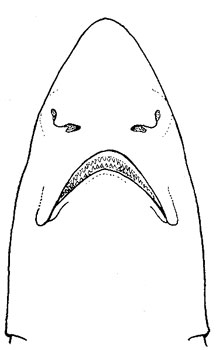
The brown smooth-hound is often taken as bycatch and discarded due to their low value. The flesh is marketed fresh, smoked, and frozen for human consumption. This abundant species is also fished recreationally by sport fishers with light tackle off the coast of California.
The brown smooth-hound is often seen in public display aquariums due to its small size and adaptability to captivity.
Danger to Humans
This small shark is considered harmless to humans. According to the International Shark Attack File, there have been no reported attacks on humans attributed to this species.
Conservation
The brown smooth-hound is not listed as endangered or vulnerable with the World Conservation Union (IUCN). The IUCN is a global union of states, governmental agencies, and non-governmental organizations in a partnership that assesses the conservation status of species.
> Check the status of the brown smooth-hound at the IUCN website.
The status of this species is not certain, however it has the potential to become depleted due to commercial fishing pressures and its low birth rate.
Geographical Distribution
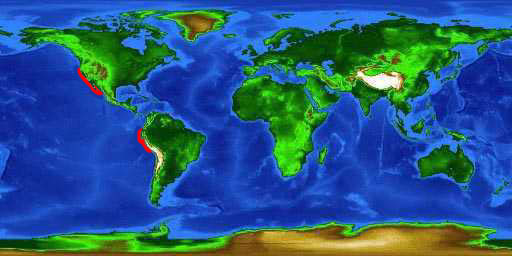
The range of the brown smooth-hound is limited to the eastern Pacific Ocean, from northern California (U.S.) to the Gulf of California, Mexico and Ecuador south to Peru.
Habitat
The brown smooth-hound is found in waters over the continental shelves and is very common in muddy and sandy bottom shallow bays. Off the coast of California, there are local populations in enclosed bays such as Humboldt, Tomales, and San Francisco Bays. This small shark lives along the bottom from the intertidal to depths of at least 656 feet (200 m), however it can be found close to the surface on occasion. It is equally abundant in inshore and offshore waters, either in schools or as solitary individuals. The brown smooth-hound sometimes associates with schools of spiny dogfish (Squalus acanthias) and leopard sharks (Triakis semifasciata).
Biology
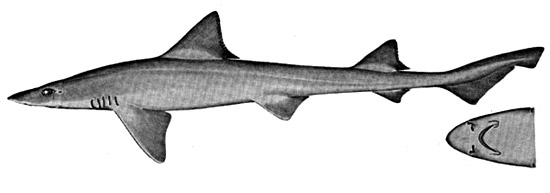
Distinctive Features
The body of the brown smooth-hound is slender and the head is rather short with a long, blunt snout. The first dorsal fin is broadly triangular with a frayed trailing fin margin. It originates above the free rear tips of the pectoral fins. The second dorsal fin is much larger than the anal fin. The pectoral fins and caudal peduncle are moderately large.
Similar species that overlap ranges with the brown smooth-hound include the grey smooth-hound (Mustelis californicus) and the sicklefin smooth-hound (M. lunulatus). The grey smooth-hound has a more posterior first dorsal fin. The sicklefin smooth-hound has a pointed, sickle-shaped lower caudal fin lobe while the brown smooth-hound’s is slightly falcate.
Coloration
The brown smooth-hound has an bronze iridescent sheen on a reddish- brown upper body. The ventral surface is white in color. There are no distinguishing markings such as spots on this shark.
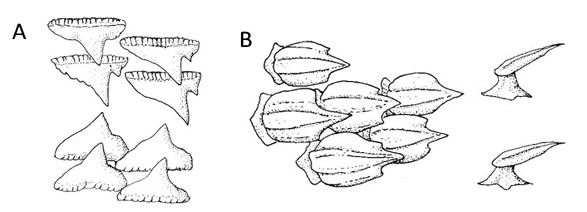
Dentition
The small teeth of the brown smooth-hound are asymmetric. The upper teeth have a median cusp flanked by a defined notch and smaller cusp while the lower teeth have cusps that are more erect.
Denticles
Dentition consists primarily of tricuspidate denticles with longitudinal ridges.
Size, Age, and Growth
The brown smooth-hound grows to a maximum of 3.2 feet (1 m) total length, with an average size between 1.6-2.3 feet (.5-.7 m). Maturity occurs in both males and females at 1.6-2.3 feet (.5-.7 m) total length, correlating to 2-4 years of age. The lifespan of this species is believed to be around 15 years.
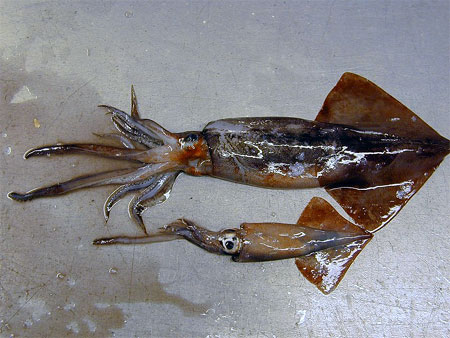
Food Habits
Prey items of the brown smooth-hound include crabs, shrimp, isopods, squid, polychaete worms and tunicates, with crabs comprising the majority of this shark’s diet. It also feeds on a variety of small bony fishes such as anchovies, surf perch, gobies, and flatfish. Adults feed on more fish than juveniles.
Reproduction
The brown smooth-hound is a viviparous species. The embryos are nourished via a yolk-sac placenta while developing inside the mother’s body. The gestation period is believed to be approximately 10 months. At the end of the gestation period, live birth occurs with 3-5 pup per litter. Each pup measures approximately 7.5-8.3 inches (19-21 cm) in length.
Predators
Larger predatory bony fishes and sharks are potential predators of the brown smooth-hound. The sevengill shark (Notorynchus cepedianus) is a known predator of this smoothhound.
Parasites
The copepods Pandaris bicolor and Perissopus oblongatus are reported parasites of the brown smooth-hound.
Taxonomy
The brown smooth-hound was originally described as Rhinotriacis henlei by Gill in 1863. This name was changed toTriakis henlei and then to the currently valid name Mustelus henlei (Gill, 1863). The genus name Mustelus is derived from the Latin “mustela” meaning weasel. There are no known synonyms used to refer to this species in past scientific literature.
Prepared by: Cathleen Bester